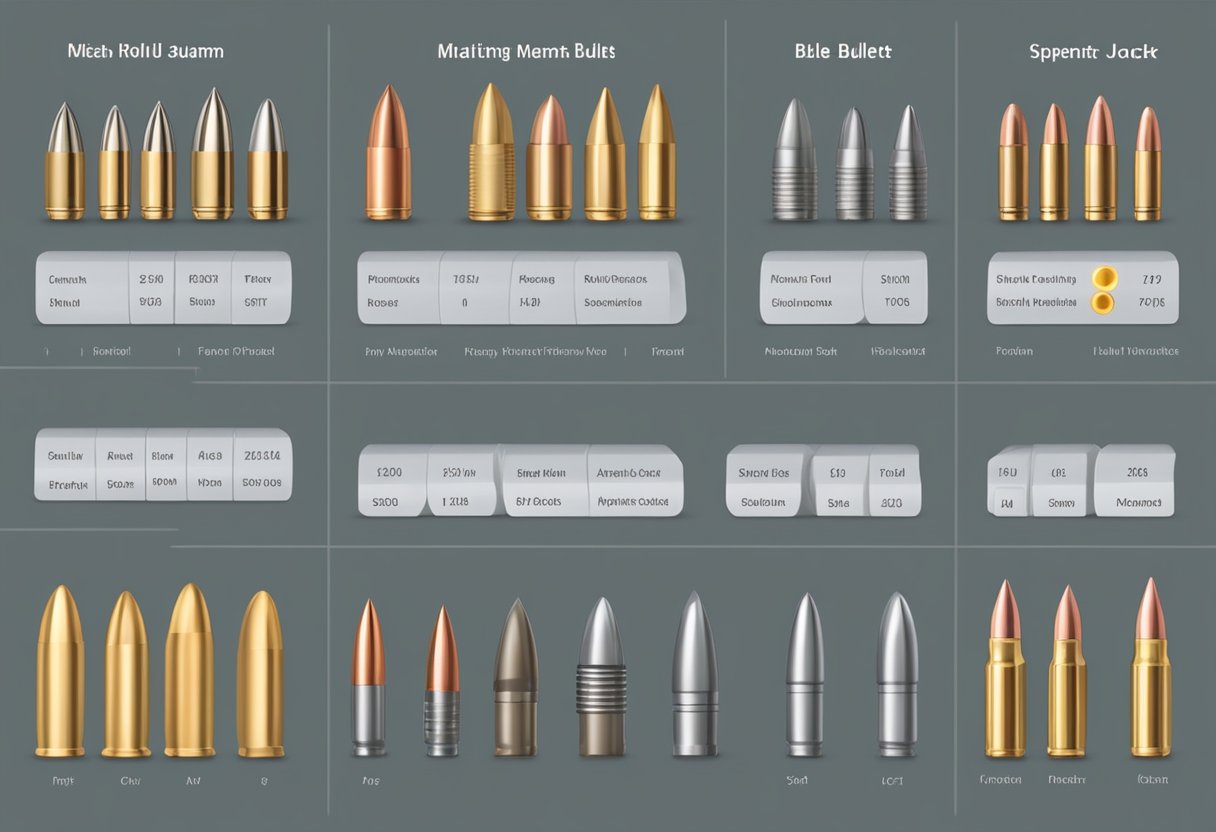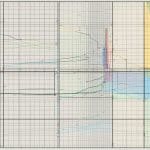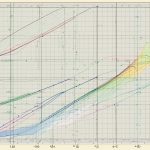Types Of Bullets
Types of bullets are an essential aspect of firearms and ammunition. There are various types of bullets available in the market, each with its unique characteristics and applications. Understanding the different types of bullets is crucial for gun enthusiasts, hunters, and anyone interested in firearms.
Bullet Basics: Understanding Sizes, Types, and Calibers
Bullets are projectiles that are fired from firearms. They come in different sizes, shapes, and calibers. The caliber of a bullet refers to its diameter, which is usually measured in millimeters or inches. The size and shape of a bullet determine its aerodynamics, penetration, and accuracy.
Common Bullet Types
There are various types of bullets available in the market, each with specific characteristics and applications. Some common bullet types include full metal jacket (FMJ), hollow point (HP), soft point (SP), and lead round nose (LRN). FMJ bullets are typically used for training and target shooting, while HP bullets are designed for self-defense and hunting. SP bullets are usually used for hunting, while LRN bullets are ideal for target shooting and plinking.
Key Takeaways
- Understanding the different types of bullets is crucial for gun enthusiasts, hunters, and anyone interested in firearms.
- Bullets come in different sizes, shapes, and calibers, which determine their aerodynamics, penetration, and accuracy.
- Common bullet types include FMJ, HP, SP, and LRN bullets, each with specific characteristics and applications.
Bullet Basics

When it comes to firearms, bullets are the key component that makes them work. A bullet is a small metal projectile that is propelled out of a firearm and towards a target. Understanding the basics of bullets is essential for anyone who wants to become proficient with firearms.
Bullet Materials
Bullets can be made from a variety of materials, including lead, copper, and steel. Lead is a popular choice because it is relatively inexpensive and easy to work with. Copper is also popular because it is non-toxic and can be used in areas where lead is prohibited. Steel is often used in military applications because it is very hard and can penetrate armor.
Bullet Calibers and Sizes
Bullet caliber refers to the diameter of the bullet and the size of the cartridge that it is fired from. Caliber is usually measured in inches or millimeters. The most common calibers are .22, 9mm, .45, and .308. Bullet size refers to the weight and diameter of the bullet. Bullet weight is measured in grains, while bullet diameter is measured in inches or millimeters.
Bullet Weight and Design
Bullet weight and design can have a significant impact on the performance of a bullet. A heavier bullet will generally have more kinetic energy and will penetrate deeper into a target. Bullet design can also affect the performance of a bullet. For example, a hollow point bullet is designed to expand upon impact, causing more damage to the target.
In conclusion, understanding the basics of bullets is essential for anyone who wants to become proficient with firearms. Knowing the different materials, calibers, and sizes of bullets can help you choose the right ammunition for your firearm and improve your accuracy and effectiveness.
Common Bullet Types
When it comes to bullet types, there are several options available to shooters. Each type of bullet has its own unique characteristics and is designed for specific applications. Here are some of the most common bullet types:
Full Metal Jacket (FMJ)
Full Metal Jacket (FMJ) bullets are the most common type of bullet used for target shooting and training. They are also used by the military and law enforcement agencies. FMJ bullets have a metal coating that covers all but the base of the bullet. This metal jacket helps to prevent lead fouling in the barrel of the firearm and also helps the bullet to maintain its shape during penetration.
Hollow Point Bullets
Hollow Point (HP) bullets are typically used for self-defense, law enforcement, and personal protection. These bullets have a hollow cavity at the tip that causes the bullet to expand upon impact. This expansion creates a larger wound channel and can help to stop a threat more quickly.
Soft Point Bullets
Soft Point (SP) bullets are a type of expanding bullet that has a partially exposed lead core at the tip. This exposed lead helps the bullet to expand upon impact, creating a larger wound channel. Soft Point bullets are commonly used for hunting applications as they are designed to provide reliable expansion and penetration.
Specialty Bullets
Specialty bullets include a variety of different bullet types, such as armor-piercing, boat tail, jacketed hollow point, open tip, and frangible bullets. These bullets are designed for specific applications and are not commonly used by the general public.
In conclusion, understanding the different types of bullets available can help shooters to choose the right ammunition for their specific needs. Whether you are looking for a bullet for target shooting, hunting, or self-defense, there is a bullet type that is designed to meet your needs.
Bullet Performance Factors
When it comes to choosing the right bullet for a particular application, there are several performance factors to consider. Two of the most important factors are accuracy and stability, as well as penetration and stopping power.
Accuracy and Stability
Accuracy and stability are critical factors for any bullet, whether it is being used for hunting, competition shooting, or self-defense. A bullet that is accurate and stable will travel in a straight line towards its target, making it easier to hit the intended target.
To achieve accuracy and stability, bullets are designed to be aerodynamic and minimize drag. This allows the bullet to maintain its trajectory over long distances, making it easier to hit targets at range.
Penetration and Stopping Power
Penetration and stopping power are also important factors to consider when choosing a bullet. Penetration refers to the ability of a bullet to penetrate through different types of materials, including clothing, bone, and tissue.
Stopping power refers to the ability of a bullet to incapacitate a target. A bullet with high stopping power will quickly incapacitate a target, making it easier to neutralize a threat.
To achieve high penetration and stopping power, bullets are designed to deliver a high impact force upon impact. This can be achieved through a variety of means, including increasing the bullet’s weight, using a hollow point design, or using a bonded core design.
Overall, when choosing a bullet, it is important to consider all of these performance factors to ensure that the bullet is well-suited for the intended application.
Ammunition for Different Uses
When it comes to choosing the right ammunition, it is essential to consider the intended use of the firearm. Different types of bullets are designed for specific purposes, such as hunting, sport, self-defense, law enforcement, and military operations. In this section, we will explore the various types of ammunition and their uses.
Hunting and Sport
Hunters and sport shooters require ammunition that is accurate, reliable, and effective. The most common types of bullets used for hunting and sport include:
-
Hollow Point Bullets: These bullets are designed to expand upon impact, causing significant damage to the target. They are ideal for hunting small to medium-sized game.
-
Full Metal Jacket (FMJ) Bullets: FMJ bullets are covered in a metal jacket, making them more durable and less likely to deform upon impact. They are commonly used for target shooting and practice.
-
Soft Point Bullets: These bullets have a partially exposed lead tip, which allows for controlled expansion on impact. They are ideal for hunting large game.
Self-Defense and Law Enforcement
Self-defense and law enforcement require ammunition that is effective at stopping a threat while minimizing the risk of collateral damage. The most common types of bullets used for self-defense and law enforcement include:
-
Jacketed Hollow Point (JHP) Bullets: JHP bullets are designed to expand upon impact, creating a larger wound channel and increasing stopping power. They are commonly used for self-defense and law enforcement.
-
Frangible Bullets: Frangible bullets are designed to disintegrate upon impact, reducing the risk of over-penetration and collateral damage. They are commonly used for indoor shooting ranges and close-quarters combat.
Military and Combat
Military and combat operations require ammunition that is reliable, effective, and versatile. The most common types of bullets used for military and combat operations include:
-
Full Metal Jacket Boat Tail (FMJBT) Bullets: FMJBT bullets are designed for long-range accuracy and penetration. They are commonly used for military snipers and marksmen.
-
Armor-Piercing (AP) Bullets: AP bullets are designed to penetrate armor and other hard targets. They are commonly used in anti-materiel rifles and machine guns.
-
Tracer Bullets: Tracer bullets are designed to leave a visible trail of light, allowing the shooter to track the trajectory of the bullet. They are commonly used for night operations and target designation.
In conclusion, choosing the right ammunition is essential for achieving the desired results. Whether you are hunting, target shooting, or engaged in combat, understanding the different types of bullets and their uses is critical for success.
Historical and Technical Insights
Evolution of Bullet Technology
The history of bullets dates back to the early 15th century when they were first used in firearms. Over the years, bullet technology has undergone significant changes, thanks to the efforts of inventors and manufacturers. One of the most notable figures in the evolution of bullet technology is John Browning, who designed several firearms that used innovative bullet designs.
The introduction of centerfire cartridges in the mid-19th century revolutionized bullet technology. These cartridges had a primer located at the center of the cartridge case, which made them more reliable and efficient than their rimfire counterparts. Today, centerfire cartridges are the most commonly used cartridges in modern firearms.
In the early 20th century, the development of jacketed bullets led to significant improvements in bullet performance. Jacketed bullets are made by encasing a lead core in a copper or brass jacket, which helps to improve accuracy and reduce fouling in the barrel.
Manufacturing and Ballistics
Bullet manufacturing is a complex process that involves several stages, including bullet design, material selection, and production. The choice of bullet caliber and weight is critical in determining the bullet’s performance. Different bullet designs, such as hollow point, full metal jacket, and soft point, are used for different applications, such as target shooting, hunting, and self-defense.
Ballistics is the science of analyzing the behavior of projectiles in flight. Understanding ballistics is critical in designing bullets that are accurate, reliable, and effective. Factors such as bullet weight, velocity, and trajectory all play a significant role in determining a bullet’s performance.
In conclusion, the evolution of bullet technology has led to significant improvements in bullet performance and reliability. The manufacturing process and ballistics are critical components in designing bullets that are effective for different applications.
Firearms and Ammunition Compatibility
Understanding Firearm Types
When it comes to firearms, there are various types and models available in the market. Each firearm has a specific caliber or gauge, which is the diameter of the bullet or shot. It is essential to understand which type of ammunition is compatible with a firearm to ensure safety and optimal performance.
Rifles, shotguns, and revolvers are the most common types of firearms. Rifles are firearms that have a long barrel and are designed to be fired from the shoulder. Shotguns, on the other hand, have a smoothbore barrel and are designed to shoot multiple pellets or a single slug. Revolvers are handguns that have a rotating cylinder that holds the cartridges.
Ammunition Classification
Ammunition is classified based on its caliber or gauge, bullet type, and purpose. The most common types of ammunition include .45 ACP, 9mm, 5.56 NATO, and .223 Remington. .45 ACP and 9mm are popular handgun calibers, while 5.56 NATO and .223 Remington are commonly used in rifles.
When it comes to ammunition compatibility, it is crucial to ensure that the ammunition matches the firearm’s caliber or gauge. Using the wrong ammunition can lead to malfunctions, damage to the firearm, or even injury to the shooter.
It is also important to note that some firearms are designed to use specific types of ammunition. For example, the AR-15 is designed to use 5.56 NATO or .223 Remington ammunition, while the AK-47 is designed to use 7.62x39mm ammunition.
In addition to caliber or gauge, ammunition is also classified based on its purpose. For example, full metal jacket (FMJ) bullets are commonly used for target shooting and training, while hollow point (HP) bullets are typically used for self-defense and personal protection.
Overall, understanding firearm types and ammunition classification is essential for safe and effective shooting. It is important to always use the correct ammunition for a firearm and to follow proper safety procedures when handling firearms.






